Jon Bennie: ‘There’s a fascination with the hidden world which is much less well studied’
Jon Bennie is an associate research fellow at the University of Exeter where he is working on a project to access the ecological effects of night-time light pollution on different plants and animals.
Could you tell me about what you study?
I’ve been working for the last five years on the Ecolight Project, which is funded by the European Research Council. We started off really trying to look at artificial light and light pollution as a concern for astronomy and for the aesthetic enjoyment of stars, but now we’re trying to find out about the ecological effects on plants and animals and the environment. It’s being driven by the growing awareness of the extent of the problem. In Europe, 60% of people can’t see the Milky Way and 88% of Europe experiences light-polluted skies.
Light is critical to all forms of life – every plant and animal gets information from natural light cycles. Daily cycles control circadian clocks. There are bimonthly lunar cycles – a lot of animals have a different physiological response to a new moon and a full moon – and different seasons. Bud-burst in trees in spring and songbird breeding rely on consistent natural light signals which give information about time and location. Dung beetles can orientate by the Milky Way. If it is obscured over large areas, what does that mean for the animals that use it to navigate?
Why are you studying it?
Humans are active during the day, but that’s pretty unusual for animals; around 70% of mammals are nocturnal. We’ve got 2,000-3,000 moth and butterfly species in the UK but only 60 are active during the day. We tend to think of things in a day-active bubble, but so many interesting processes and interactions happen at night. As we envelop ourselves in this luminous fog at night-time, trying to make the night more like the day, there are implications for a whole range of species. There are two aspects: the direct impact on wildlife in our towns and cities, and then the wider countryside which is affected by sky glow and the effect of fragmentation. We wanted to find out about this.
What have been your most important findings so far?
The difficulty is trying to pin down the effects of sky glow. We know indirect illumination has effects on both plants and animals, and there is an increasing amount of research being done in this area, but there still aren’t many case studies. We found that predatory ground beetles, spiders and some bat species (pipistrelles) group around streetlights, because they use the artificial illumination to gain an advantage while hunting their prey. We’ve been looking at whether effects can cascade up and down food webs. We found a direct effect of low-intensity light on the flowering of a few plants, which in turn reduced aphid numbers, showing that the light-based effects on one species can cascade to the species that feed on them, and we expect they will be able to cascade further than this.
The challenge here is finding out at what level of the ecosystem these effects are occurring. We know that if we illuminate an ecosystem it changes, but every time we do an experiment we find a new response that we’ve never thought of before. We’ve been running this experiment for four years and even in the simple systems, unpicking the pathways is difficult.
What drew you to studying at night?
I started off as an ecologist looking at plants and plant-and-insect interactions. Like most ecologists, I was out doing fieldwork during the day but it suddenly occurred to me that the majority of stuff is going on at dawn and dusk and during the night. There are challenges with studying things at night, but there’s that fascination with the hidden world which is much less well studied. Most of the places people go to watch wildlife, such as African plains, are unusual places, with a lot of animal activity during the day.
What’s challenging about working at night?
If you want to study what things are doing in the darkness, you have to do it in the dark and that causes problems with simple things like writing notes, running equipment, that sort of thing. There are other issues with doing fieldwork in more urban areas; I’ve had the police come along and ask me what I’m doing a couple of times!
We’re dismantling one of our experiments that has been running for five years now, which was more controlled, with net cages. We’re getting the last of the data from that at the moment. Our current study has been going for four years now and we haven’t got any plans to stop at the moment. It sort of depends on whether we’ve got the funding and people. We need a team to conduct the fieldwork and maintenance. We’ve had three of us working full-time on the project, a technician and two researchers, but it can be difficult to get people to work on the project early in the morning and late at night.
Is it difficult to stay mentally alert at night, or does the quietness encourage contemplation?
I think the stillness really helps me think, but more late at night than if I’ve got up before dusk. I’m more of a night owl than a morning person, so I struggle with the mornings sometimes.
Working at night, do you ever feel spooked or lonely?
Yeah, absolutely. I think that’s part of the fun of it. I grew up in Devon where I did a lot of camping and walking, and walking back from the pub in the pitch darkness without streetlights, so I’m pretty used to being on my own in the dark. Still, you hear strange noises sometimes and you get spooked. I do feel safer out there in real darkness though, rather than in a lit town. I once had a run-in with a couple of angry badgers in the middle of the night. I was walking along and two of them exploded out of the vegetation near me. It certainly gave me a shock.
Most people are asleep while you’re working. What are we missing out on?
Things like the quality of light in the mornings, the stillness. It’s beautiful to hear the dawn chorus out in the open. The amount of wildlife activity that happens during the night is incredible – bats, owls, badgers, all the nocturnal species. Seeing the difference in moth activity or owls’ hunting patterns between a new and full moon is amazing. You feel like you’re more in tune with nature and can look up at the night sky without all the light pollution near populated areas.
What is the end goal of this entire project?
We want to be able to find out about the effects of artificial light on species so that we can inform governments about how to lower the impacts of our lighting. Currently, lots of white LEDs are being used for street lighting, but they are actually blue LEDs with a white phosphor coating. This blue light affects a lot of wildlife much more than other types. We really hope to provide an evidence base which supports keeping important ecological areas unlit.
The main steps that can be taken are split into four groups: reducing the number of areas that are lit; in those which are lit, reduce the duration of lighting; change the type of light being produced so that it has the lowest ecological effect; change the design of lights (eg shielding them so that they only light a very specific area) to make them more friendly to local species.
What could people do with their own outdoor lighting to reduce their effect on local species?
People could make shields for their current lights, or buy lights that come with a shield attached. These angle the light downwards to a specific area, preventing it from spreading over foliage and therefore reducing the chance that it will impact creatures near your house.
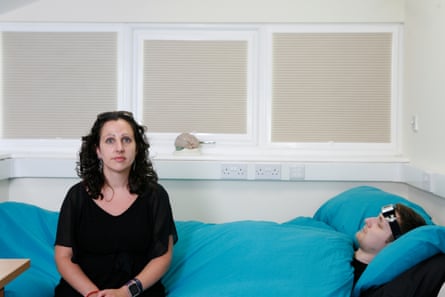
Photograph: Gary Calton/The Observer
Caroline Horton: ‘The only problem is that sometimes people start dreaming about the lab’
Caroline Horton is a senior psychology lecturer at Bishop Grosseteste University in Lincoln. Her research concerns sleep, dreaming and memory, with a special focus on how dreaming consolidates memories from our waking lives. She has set up a dedicated laboratory for studying dreams, called DrEAMSLab (Dreams, Emotions, Associations and Memories in Sleep Laboratory), which launched in February 2016.
What are you studying?
I’m interested in how dreams improve memory. A lot of organising and reshaping happens when we’re asleep. Dreams help consolidate memories by sifting through what happened that day, deciding what we can forget and starting to set things we need to remember into long-term brain structures. Everybody has dreams, whether you remember them or not, so as a psychologist they are fascinating.
How do you gather your research?
Most of our studies take place in people’s homes. In a recent study, we gave the subjects a Dictaphone and a programmed alarm clock, and asked them to record their dreams at four different points over two nights, to see how dreams changed through the night. But this year we’ve launched the DrEAMSLab, where we can use electrodes to monitor people as they sleep. It’s a small, cosy bedroom with blackout blinds and a computer, as some of our experiments involve asking people to learn something before they go to sleep. The only problem so far is people sometimes start dreaming about the lab, while the home is a more natural environment to collect data in.
Why are some dreams so strange?
It’s a common misconception that you only dream during rapid eye movement (REM) sleep. In fact, you dream all the time. Sleep is deeper in the first four hours of the night, and dreams in that period are shorter, and more mundane – you might dream about being at work, for instance. These dreams are reactivating memories from the previous day to see which ones need to be consolidated. During REM sleep, your brain is very active, so dreams become more complex and story-like. They can be bizarre because new memories are put into different contexts, to make them more memorable. Old memories tend to crop up more often – for example, you might dream about someone you saw on TV that night speaking in an office conference room you used three years ago. And because your brain is almost awake during REM sleep, those dreams are easier to remember.
Why do we have nightmares?
People often dream of emotionally intense experiences from waking life, both positive and negative, because they’re important to remember. Sometimes, our brain runs through potentially scary or dangerous situations, so we are better equipped to cope if they happen in real life – like dreaming about the gear stick jamming when you’re driving, for instance. It’s also about using our past experience to help us in the future. Before exams, people have a lot of dreams about feeling unprepared. And if you wake up feeling unprepared, you’re more likely to get your head in the books.
Why do old places or people from childhood crop up in dreams?
You’re more likely to dream of life events that happened in your late teens and early 20s, as at that age you’re experiencing a lot of new things – moving away from home for the first time, or your first relationship. You’re at peak memory health when these are happening, and they can be emotional, so they’re the strongest memories in the system and appear in dreams throughout your adult life, often combined with new memories. Don’t worry, it probably doesn’t mean you’re still pining after your first love!
Is everything we dream related to memory?
The more often you record your dreams, the better you get at identifying which memory each fragment is from. I’ve been recording my own dreams for years and have become very good at it. But some things do come up that seem totally random. If you’re a creative person, like an artist, you’re more likely to have more creative, fanciful dreams, while individuals who experience psychosis have much more disassociated, bizarre dreams.
Can we interpret our dreams?
We usually dream of things from our everyday lives, and each dream is personal and unique to the dreamer. So I wouldn’t advocate a “dream language”. As a scientist studying dreams, it can sometimes be tricky explaining our work, as people still associate dreaming with subjective, therapeutic art forms. Sometimes the answer is simple – people who dream about losing teeth a lot are probably just grinding their teeth while they’re asleep.
Does cheese give you weird dreams?
Yes, we think so. This could be because cheese is very salty and so can make you wake up earlier because you’re thirsty, and so can catch you in the middle of a dream. But we don’t yet know whether it affects dream content and the types of memories that are activated.
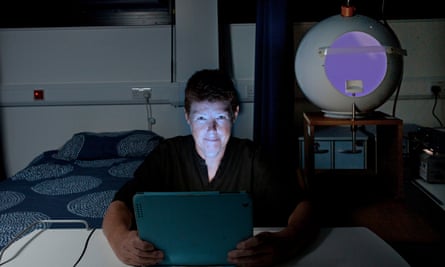
Debra Skene: ‘We know the value of sleep, yet we’re often awake at night’
Debra Skene is a professor of neuroendocrinology at the University of Surrey. She studies the human circadian timing system and how it becomes disrupted in blind people, shift workers and older people. Her team’s discovery that blue light from sources such as iPads can alter the timing of this system has important implications for how we sleep.
What are you studying?
I study human circadian rhythms and sleep. Everything in our body is rhythmic, from the release of hormones to our behaviour, and we’ve developed these circadian rhythms because we live on Earth, which has a light-dark cycle and a periodicity of 24 hours.
We used to think there was just one clock in the brain controlling these rhythms, but we now know that we have clocks in just about every tissue in our body. We are trying to understand how all of these clocks speak to one another and stay in tune, and how they are affected by time cues such as exposure to light or meal times. For instance, when we wake up and open our eyes each morning we get a direct feed of light into our brains, and this resets our internal timing system to be in tune with the natural 24-hour rhythm of earth’s rotation.
Why are you studying this?
So that we can help people synchronise to new time zones or shift patterns, and have treatment strategies for people whose circadian rhythms are out of sync. For instance, totally blind people can’t synchronise their central body clock with the daily light-dark cycle, and the result is that they’re essentially jetlagged a lot of the time.
Also, we need to better understand how light exposure affects our internal clocks to ensure that we get the right amount of light to maintain alertness during the day and good sleep at night.
What are you observing?
We measure people’s mood, performance, sleepiness, hormones and metabolites [the products of the chemical reactions happening within our bodies] throughout the day and night, in order to understand which rhythms are truly circadian, ie generated by this internal clock timing system. This involves removing all of the external factors that could influence their rhythms, so volunteers are kept in a constant, semi-recumbent posture for 40 hours in dim light and at a constant temperature. They are not allowed to sleep, and instead of breakfast, lunch and supper, we give them small, hourly snacks. We wire them up so we can check their brain activity to see if they are falling asleep and we can wake them up.
We also get people into the lab and deprive them of sleep, in order to understand what’s happening in people’s bodies during the first night of night shift work.
What do you find fascinating about your subject?
All scientists are drawn to what we don’t know. What currently most interests me is the link between the timing of our clocks and metabolism. We know that long-term shift workers have an increased risk of metabolic disorders such as type 2 diabetes and a tendency to be more obese; we’re now trying to work out the mechanisms behind this relationship.
What are the challenges you face working at night?
One of the biggest obstacles is getting people to stay awake during our experiments. At 4am, people are sleepy, but we can’t go in and overexcite them because that might affect our results. Instead we have to walk in quietly and talk to them about some relatively boring subject. Everything is done in time isolation, so no one has access to what the time is, the internet or the wireless. Volunteers can watch videos, but it has to be from afar, so that the light on the screen isn’t bright enough to affect their bodies.
Do you employ any special equipment?
Another challenge we face is making sure everyone is at the same baseline when they come into the lab, and they’ve been maintaining a regular sleep-wake cycle in their own homes. This is to minimise the variance between people and ensure that when we measure something, it’s the effect of what we’re testing and not the result of differences in people’s circadian timing. To do this, we use actiwatches – small accelerometers worn on the wrist that record how much people have moved, which is a proxy for when they’re active and not active – and ask all our participants to complete sleep diaries. The actiwatches also have light sensors, which tell us how much light they’ve been exposed to and when.
Our group is famous for showing that blue wavelength light has the greatest effect on the human circadian system. To do this, we had to put participants’ heads into an integrating sphere – a reflective dome that bounces light around inside it, so that when you put your head inside it your entire retina is equally illuminated.
Is it difficult to stay mentally alert at night?
We always work in shifts when we do overnight experiments, so one group works from the evening up until about 2am, and another does from 2am onwards. Generally you are so busy taking blood samples and spinning them down, or asking participants questions about how alert they feel that although you’re tired, you stay awake. The other thing I’ve noticed, which is generally common in shift workers, is that I love eating sugary things, such as biscuits or jam and toast, that I would never normally eat. We think that timing of unhealthy food consumption could be a key factor in the ill-health of chronic shift workers, although exactly why we crave these types of food at night needs more research.
Would you describe yourself as a night owl, or an early-morning person?
I am a late type, so it is easier for me stay up quite late at night, which helps. One thing we’re trying to do as a field is to identify people’s chronotypes – their propensity to be alert at different times of day – and match this to their shift patterns, to see if this makes any difference to their coping with shift work.
Are you concerned about the effects of your working hours on your health or wellbeing?
We always joke when we go to sleep conferences that we know the value of sleep, and yet we’re often awake at night, so the irony isn’t lost on us. I’m also aware that when I fly across time zones, it isn’t very good for my body either. It is something that you just have to do.
Do you have any tips for staying up late/managing the body clock?
Try to take a nap before you go on to your shift – although the problem here is that in normal circumstances, when you’re synchronised with the light-dark cycle, it’s not easy to take a nap in the evening. Another tip is to be in bright light during the early part of your shift if possible, and near the end of the night shift, reduce light exposure. Also, we insist that everyone – volunteers and staff – sleeps in the lab and are fully rested before they go home, or they get taken home in taxis, so that there is no risk posed by them driving.
Most people are asleep while you’re working. What are the rest of us missing out on?
Normally, as a late type, I sleep through the dawn, but one of the great things about being a night worker is becoming much more conscious of it. It’s nice and quiet, you can hear the birds, and that early dawn light – the sort you get even before you see the sun – I think that’s a memory that sticks with you.
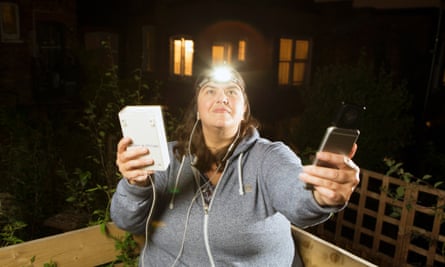
detecting equipment. Photograph: Richard Saker/The Observer
Kate Jones: ‘I’ve been bitten, but never by a vampire bat’
Kate Jones is a professor of ecology and biodiversity at University College London with a special interest in bat research and conservation. She won the Philip Leverhulme award in 2008 for outstanding contributions to zoology. A former chair of the Bat Conservation Trust, she is a scientific adviser to a number of conservation charities. She lives in London.
How and why did you get into bats?
My first contact was as an undergraduate, checking boxes with one of the professors in the North York Moors. He came down a ladder with a load of bats in his hand. There was one who was asleep and when he placed it in my hand it woke up and looked at me as if to say “What do you want?” I just thought that was so badass. That was it for me.
I’ve tried to avoid being a bat specialist as that can pigeonhole you. I try to look at the bigger picture, but always with a cunning eye on bats. They do so many weird things and so little is known about them – that’s what really draws me to them.
What makes bats unique?
They are so cryptic – they come out at night, but you don’t see them. They are the only mammal that has proper power of flight. They can live for a really long time – up to 30-40 years – in the largest aggregation of mammals on the planet. They also host diseases that transmit to humans – Ebola, Sars. How do they host them and how do their immune systems cope? How have they evolved such a sophisticated system as echolocation?
What are some of the current conservation issues facing bats?
Land-use change, such as deforestation and conversion of land for agriculture. Persecution – many people still view bats as pests or vermin and they lack legal protection in many countries. And introduced species such as snakes or rats. Bats might be slightly better able to cope than some as they can fly away, but they are attached to flyways and migration routes and it takes them a long time to recover from any population crash or disturbance.
How have bats been affected as society has become more 24/7?
It’s difficult to say – some species really don’t like light, it interferes with their hunting. But the most common British species, pipistrelles, are drawn to lights because they attract the insects which the bats eat. Urbanisation could be more sympathetic, with less light pollution and increased habitat for wildlife.
Why are bats demonised? Is it because they are nocturnal?
I think it’s because maybe they are so secretive and cryptic by nature. There is the vampire thing that has been totally overblown, lots of negative media stories and preconceptions. There are 1,400 species of bat; only three are vampiric and they are in South America. It is a bit crazy.
Have you ever been bitten?
I have been bitten lots of times, but never by a vampire bat and I do have a rabies jab. But I have been infected by histoplasmosis – probably from when I was bat-tracking in Puerto Rico’s hot caves. It’s infection caused by a fungus found in bat guano. It has left a lot of calcified nodules on my lungs.
What sort of research do you do at night?
Typically we would go out to a region or neighbourhood and train up local groups to use sensors and record the bat species. In Puerto Rico we spent a couple of weeks catching bats in mist nets at night to measure the impact of a recent hurricane. Or we’d head out at dusk to do a walking transect survey, setting detectors and looking for roosts.
Do you get scared?
I took a BBC team out to Hampstead Heath and they were all freaking out that it was the middle of the night, but for me it was completely normal. There are so many things to see after dark – bats, hedgehogs, foxes, owls, nightjars, crickets and cicadas.
Are you a night owl?
I’m not a big sleeper anyway. Sometimes it can drag a bit but lots of exciting things happen at night. When you’re driving around different countries with sensor equipment stuck out the window, you can find yourself in strange situations where people think you’re up to no good. We’ve had guns pointed at us in Romania and Ghana.
Any tips for staying up late or managing the body clock?
A nice shower in the morning usually sorts me out.
How does night-time work affect family and friends?
Many are happy to come out for an hour or so. But staying out all night is beyond most people, and hardly anyone wants to come out for the dawn swarm at 3am. That’s the worst part of the night – too late to be that day but too early to be the next.
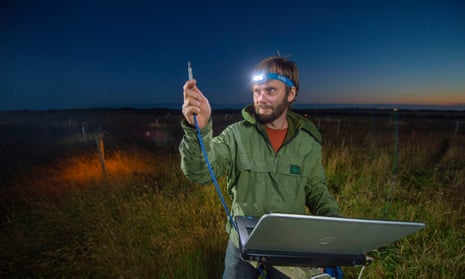

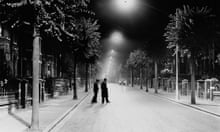








Comments (…)
Sign in or create your Guardian account to join the discussion